Your property might be built on a sloping landscape or hillside. Maybe it’s your front yard that’s dropping down toward a walkway, or maybe it is dropping to a less visible area, which is equally problematic.
Regardless of the situation, there’s a lot you can do with a sloping landscape. Slopes and hills pose numerous challenges for landscaping and planting in Sydney. Besides being awkward, they pose treacherous maintenance.
Their growing conditions and soil quality are hardly the best. Additionally, hillsides aren’t good at retaining water.
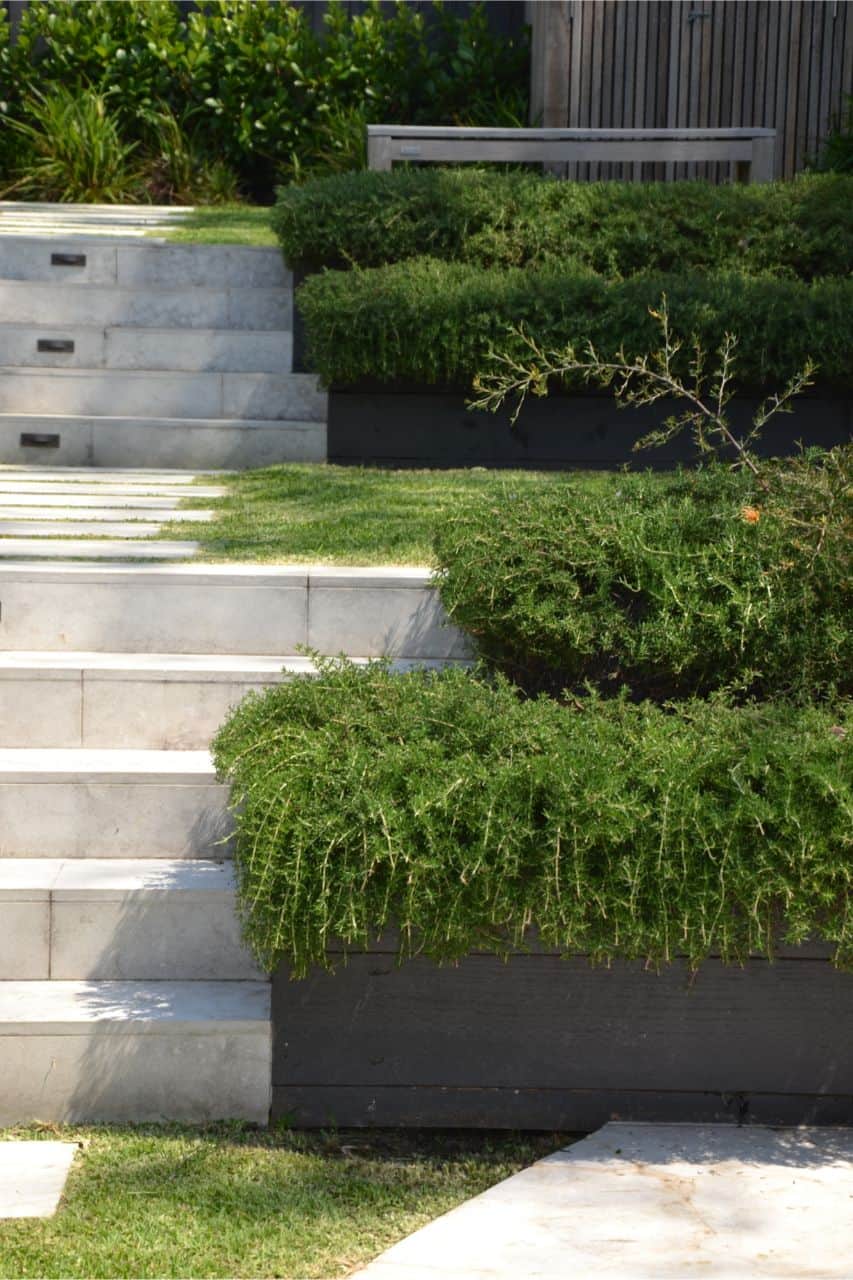
Even if much of your landscape features a lushly planted lawn or garden, hilly areas will be more affected by drought due to their poor water retaining nature.
To make matters worse, erosion washes away nutrients and topsoil from a hilly landscape whenever it rains heavily.
Moreover, fast surface runoff worsens the situation further. Thus, dealing with a sloped landscape is extremely challenging. However, that doesn’t make it useless. Sloped landscapes are still manageable.
First, consider whether you’re ready to do major hardscaping and earthmoving work. If your budget allows, you can hire a landscaping contractor to do the tough work for you.
The contractor can assist you to break down the slope into flat, manageable plating areas by constructing terraces and retaining walls.
If you can’t afford to hire a contractor or a skid loader due to limited finances, and you lack enough time to do the work with a hoe and shovel, don’t worry much. You can still try out other remedies to fix the slope issue.
Solutions for Fixing a Slope
One of the most ideal long-term solutions for fixing a sloping yard is getting rid of the slope. However, this is a tough task. Nevertheless, it’s a great option that’ll make it possible to incorporate landscape features into a sloping section of your lawn.
We’ve prepared a guide on workable hillside landscaping ideas and solutions. We’ve organized the solutions in order from the easiest solution to the most challenging solution
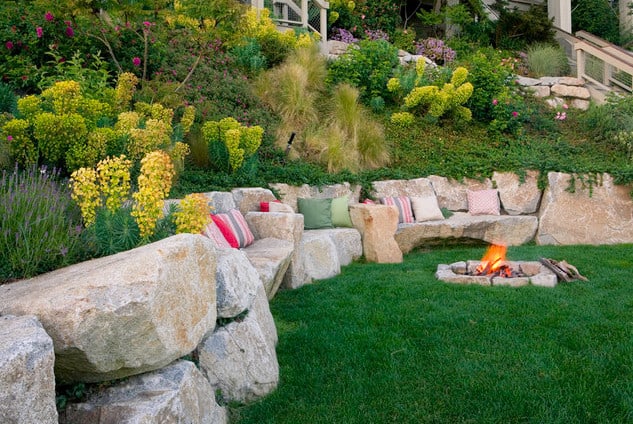
Easiest Solution – Use Hill-Friendly Plants
Plant species that are drought tolerant with deeply spreading roots are ideal for planting on a sloping yard. Besides, they can assist in preventing future erosion.
Shrubs, trees, and perennials are some of the best plant options for slopes. They develop a deep network of roots. Besides, such plants won’t require you to keep climbing the slope as they don’t demand a lot of maintenance upon maturing.
However, planting on a slope requires some extra work. It’s a bit more challenging to plant on a slope than on a level garden. If you want to plant successfully on a slope, then you’d rather transplant established seedlings rather than sowing.
The reason behind this is that seeds can easily get washed down the slope. Seeds are too light to withstand water forces. Here’s a strategy for planting on a sloped landscape:
Step #1: Flatten the Planting Area
First, excavate the hilly landscape to create several flat areas for planting seedlings. Each planting area should be at least 2 or 3 times larger than the root ball or plant container in terms of diameter.
However, don’t disturb the soil excessively. Freshly cultivated soil can get washed away easily.
Step #2: Create a Berm
Gather the soil you excavated in the previous step and pile it to create a berm shaped like letter “U” around the sides and front edging of the area you’re planting.
Ensure the berm has a height of 3-6 inches. The height will depend on the slope’s steepness and the size of the plants.
Tamp the soil making up the berm. Maintain a barrier around the spot you’ll be making the planting hole. You can stabilize the berm by staking some strips of a landscape fabric around it.
You can also stabilize it with a pantyhose filled with soil. In this case, wrap the pantyhose around the area you’re planting and stake it down for a secure fit.
Step #3: Prepare a Planting Hole
You can now dig a planting hole depending on the recommended depth and size. Start amending and preparing the soil in readiness for transplanting the seedlings.
Step #4: Start Planting
Take your transplant and inspect it to ensure its stem is straight. The stem should also be lined in a vertical orientation.
Mound soil all around the root section of the plant. Pack the soil properly and avoid mounding the stem. Do the same for all plants.
Step #5: Apply Mulch
You can now add mulch on the berm and planting area. Use heavy mulch for the best results. Ensure you don’t cover the stem when applying mulch. Water the plant regularly.
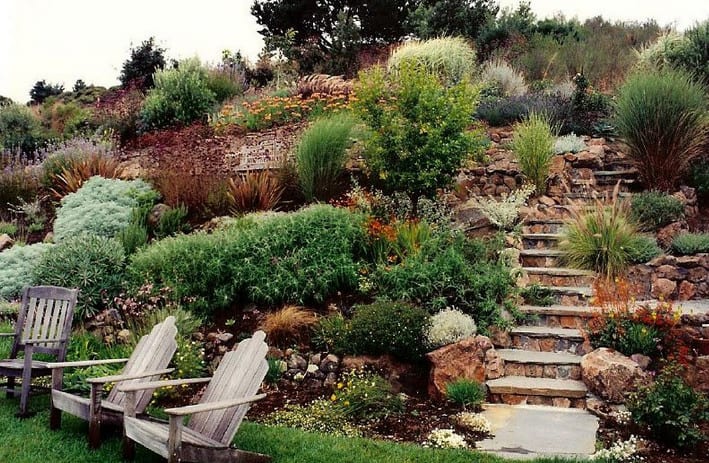
Moderate Solution – Trenches and Terraces
You can also manage a mildly sloped landscape by terracing it to form planting areas on the hillside. In this case, you’ll need to create flat areas for planting in the form of an array by making trenches along the hill.
The planting zones should be contoured. Also, create planting areas that are big enough to plant several plants.
When making trenches, ensure their bottom is flattened but slightly pitched backward toward the slope. Create a berm along the front area of the excavated trench.
The berm should be built to a height of 3-6 inches. The berm will assist in slowing down surface runoff since some of the water will collect in the trench and get to the roots.
A short stack or row of medium-sized rocks set along the front and back edges of the excavated trench can prevent soil from being washed down into the trench. As such, the newly created topography is preserved.
It’ll also keep the plants protected. You can as well use treated posts, landscape timbers, pavers, or landscape blocks along the back area of every trench.
Select plants carefully and apply mulch and groundcover around the plants to assist in holding soil around them.
Tip: Rather than lining the front or back section of each trench with rocks, build a buffer with a piece of landscape fabric by creating a snake out of it.
Fill the snake with drainage rocks and position it along the trench. The snake should have a diameter of 4-8 inches for more effectiveness.
Secure it in place with spikes driven into the soil after every 12-24 inches. Use mulch to cover the fabric and trench.
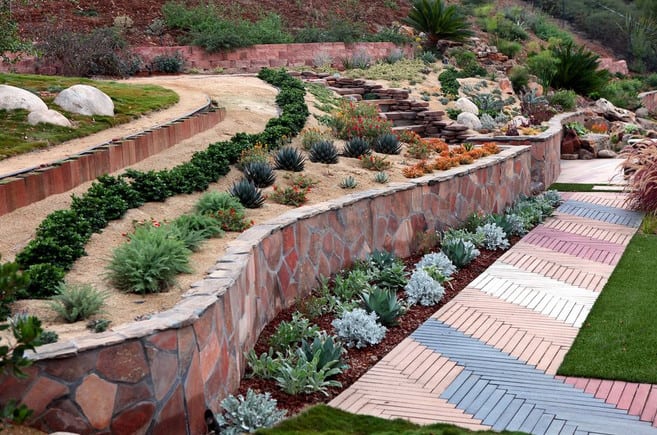
Labour Intensive Solution – Creating Retaining Walls
If you’re dealing with a larger slope, then you need a more permanent solution to manage the hillside and put it into useful use. Building retaining walls is one of the best permanent solutions.
Retaining walls can withstand a lot of force and pressure from the soil and water runoff behind them. The walls should be anchored in a sub-base.
They should also have a strong structural design and good drainage. Properly installed retaining walls should have a pitch that leans backward to take advantage of gravity.
Interlocking blocks are one of the most preferred materials for constructing retaining walls. Interlocking blocks come in a wide range of surface textures, sizes, and colours. They have been around for several years now.
Installing them involves adding a sub-base of gravel below the retaining wall area. A perforated drainage tile is also added.
The drainage tile features an outlet that drains water runoff. It’ll help better to install the base on top of the landscape fabric.
The fabric should be installed in such a way that it extends beyond the top section of the excavated area. That way, it’ll reduce weeds and keep the structure stabilized.
Lay the base some inches below the grade and upside down. Subsequent courses of the blocks should be installed with a little pitch toward the back. Some blocks should be secured with a landscape adhesive between them.
Other types of blocks are secured with pins. Some blocks come with calibration marks that assist in creating a symmetrical layout.
The top course should have a cap design to make the wall look more appealing. Upon building the wall, backfill it with enough soil.
You can also use natural materials such as landscape timbers and fieldstone to build retaining walls. They’re also durable as long as you choose high-quality materials and create a strong sub-base with proper drainage and a weed protection mechanism.
When using fieldstones, ensure the stacks are slightly pitched toward the back and arrange them in such a way that gaps between them are as tiny as possible.
Timber can also be used to construct small retaining walls. In this case, ensure the pieces of timber slant a little backward.
Also, ensure the pieces of timber are secured together with screws. You can also drive rebar through guide holes to fasten timber pieces.
You can prevent the created wall from inclining forward by adding a piece of deadman in every course. This is a piece of timber installed perpendicularly toward a wall such that its front section fits within a wall and extends back into the slope.
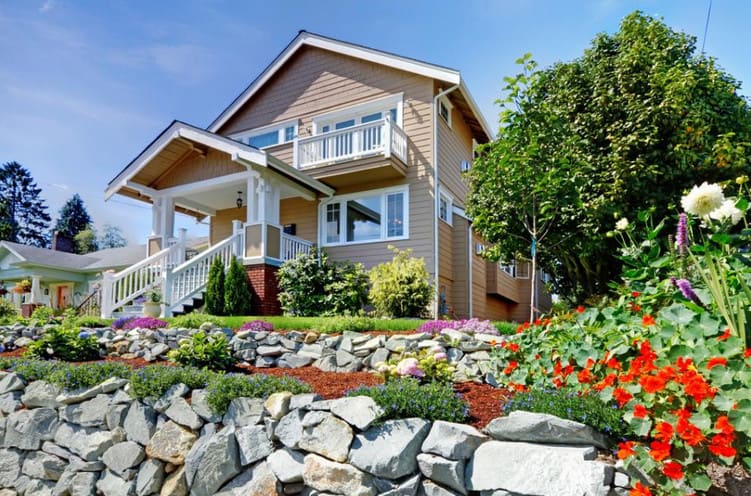
Plants That Thrive on a Slope
Shrubs:
- Dwarf Forsythia
- Burning Bush
- Japanese Yew
- Carpet Cypress
- Sumac
- Lilac
- Creeping Juniper
Groundcover:
- English Ivy
- Cotoneaster
- Vinca (Periwinkle)
- Rockrose
- Rosemary
Native Wildflowers:
- Violets
- Echinacea (Coneflower)
- Russian Sage
- Daylilies
Ornamental Grasses:
- Canada Wildrye
- Bluestem Switchgrass
- Red Fescue
Looking for a Reliable Landscaping Company in Sydney?
NBG Landscapes is a licensed and experienced company offering landscaping services in Sydney. Our landscapers have over 10+ years of experience in providing landscape services to residential and commercial properties in Sydney. Call us today for a free quote!
